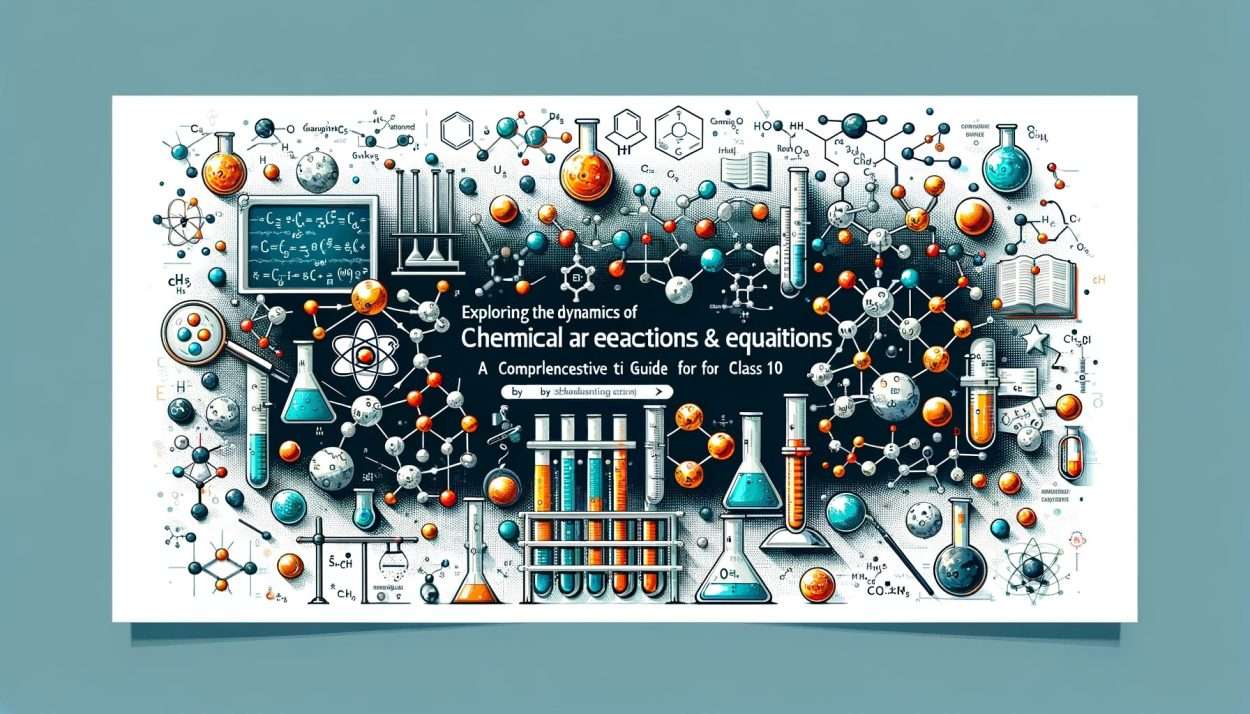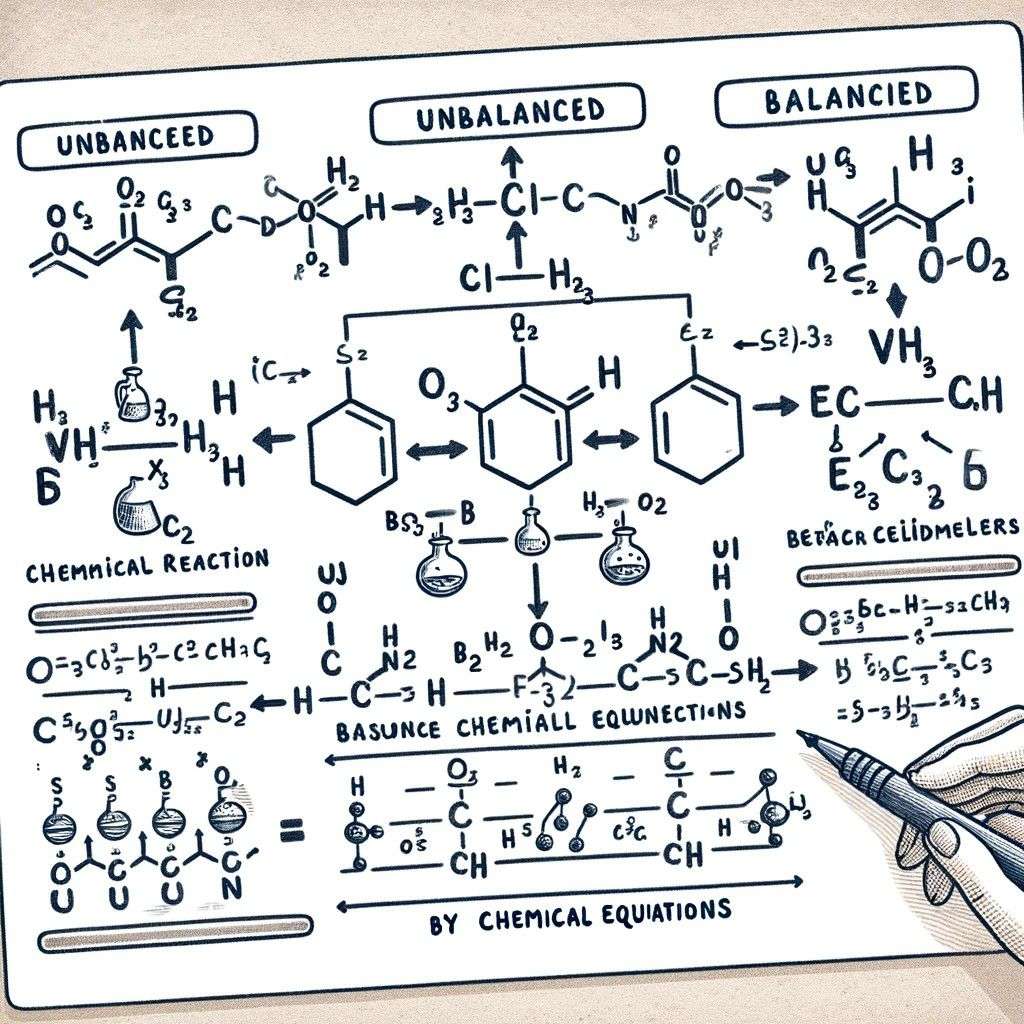
Exploring the Dynamics of Chemical Reactions and Equations in Science – A Comprehensive Guide for Class 10

1. Introduction to Chemical Reactions
Understanding Chemical Reactions:
- A chemical reaction is a process where substances, known as reactants, transform into different substances, called products. This transformation involves breaking and forming of chemical bonds, leading to changes in the properties of substances.
Observing Chemical Changes:
- Chemical changes can be observed through indicators like color change, temperature change, formation of a precipitate, emission of gas, or change in odor.
- For example, when iron rusts, it turns reddish-brown, indicating a chemical reaction where iron reacts with oxygen to form iron oxide.
- These changes are distinct from physical changes, which don’t result in the formation of new substances.
2. Writing Chemical Equations
Representing Chemical Reactions:
- Chemical equations are symbolic representations of chemical reactions. The reactants (substances that react) are written on the left side, and the products (newly formed substances) are written on the right, separated by an arrow indicating the direction of the reaction.
- Each chemical substance is denoted by its chemical formula, which provides information about the elements present and their proportions. For example, the burning of methane in oxygen can be represented as: CH₄ + 2O₂ → CO₂ + 2H₂O.

Balancing Chemical Equations:
- Balancing a chemical equation is crucial because it ensures the law of conservation of mass is followed, meaning the number of atoms of each element remains the same before and after the reaction.
- To balance a chemical equation, one adjusts the coefficients (the numbers before the chemical formulas) so that the number of atoms of each element is equal on both sides of the equation.
- For instance, in the methane combustion equation above, the coefficients are adjusted so that there are equal numbers of carbon (C), hydrogen (H), and oxygen (O) atoms on both sides.
Balancing chemical equations is a fundamental skill in chemistry, as it reflects the stoichiometric relationships between reactants and products in a chemical reaction. It is essential for understanding the quantitative aspects of chemical reactions.
3. Types of Chemical Reactions
Combination Reactions:
- Definition: Combination reactions involve two or more substances, typically simple ones, combining to form a more complex product.
- Example: A common example is the formation of water (H₂O) from hydrogen (H₂) and oxygen (O₂) gases: 2H₂ + O₂ → 2H₂O.
- Significance: These reactions are fundamental in various synthetic processes in chemistry and industry, like the formation of ammonia in the Haber process.
Decomposition Reactions:
- Definition: Decomposition reactions involve a single compound breaking down into two or more simpler substances. These often require an external source of energy, like heat, light, or electricity.
- Example: The breakdown of calcium carbonate (CaCO₃) to calcium oxide (CaO) and carbon dioxide (CO₂) on heating: CaCO₃ → CaO + CO₂.
- Applications: Decomposition reactions are crucial in various industrial processes, such as the production of cement and lime, and in the decomposition of organic matter.
Displacement Reactions:
- Definition: These reactions involve an element displacing another from its compound. They are characterized by the activity series, which predicts the ability of metals to displace others from solutions.
- Example: Zinc metal displacing copper from copper sulfate solution: Zn + CuSO₄ → ZnSO₄ + Cu.
- Relevance: Displacement reactions are widely used in metallurgy for extracting metals from their ores.
Double Displacement Reactions:
- Definition: In these reactions, ions exchange between two compounds, forming two new compounds.
- Example: The reaction between sodium sulfate (Na₂SO₄) and barium chloride (BaCl₂) to form barium sulfate (BaSO₄) and sodium chloride (NaCl): Na₂SO₄ + BaCl₂ → BaSO₄ + 2NaCl.
- Importance: Double displacement reactions are common in various areas, including chemical analysis, industrial manufacturing, and biological systems.
Oxidation and Reduction:
- Definition: These are reactions where electrons are transferred between substances. Oxidation involves the loss of electrons, while reduction involves the gain of electrons.
- Example: In the reaction between hydrogen and oxygen to form water, hydrogen is oxidized (loses electrons) and oxygen is reduced (gains electrons).
- Redox Reactions: Oxidation and reduction always occur together in what are known as redox (reduction-oxidation) reactions. For example, when magnesium reacts with oxygen to form magnesium oxide, magnesium is oxidized and oxygen is reduced: 2Mg + O₂ → 2MgO.
- Applications: Redox reactions are fundamental in various chemical processes, including energy production in batteries, combustion in engines, metabolic processes in living organisms, and corrosion of metals.
Each of these reaction types plays a critical role in both natural processes and industrial applications. Understanding these reactions helps in the study of more complex chemical interactions and is essential for students in comprehending various aspects of chemistry and its practical applications in the real world.
4. Effects of Oxidation Reactions
Corrosion:
- Definition and Process: Corrosion is a naturally occurring process that results in the gradual destruction of materials, usually metals, by chemical reactions with their environment. It is an electrochemical process involving oxidation.
- Mechanism: In corrosion, the metal is oxidized; it loses electrons and forms oxides. A common example is the rusting of iron. When iron is exposed to oxygen and moisture, it forms iron oxide (rust): 4Fe + 3O₂ + 6H₂O → 4Fe(OH)₃.
- Impact: Corrosion leads to the weakening of structures, failure of parts, and loss of functionality, causing significant economic losses in industries and infrastructure. For example, rusting can weaken bridges, pipelines, and vehicles.
- Prevention: Methods to prevent or slow down corrosion include painting, galvanization (coating with zinc), using corrosion inhibitors, cathodic protection, and choosing corrosion-resistant materials.
Rancidity:
- Definition and Context: Rancidity is the process in which fats and oils are oxidized, resulting in unpleasant smells and tastes. This oxidation reaction mainly occurs in food products.
- Types of Rancidity:
- Hydrolytic rancidity occurs when water causes the breakdown of triglycerides into fatty acids and glycerol, changing the odor and taste.
- Oxidative rancidity involves the reaction of fats with oxygen, leading to the formation of aldehydes and ketones with strong and often unpleasant odors.
- Impact on Food: Rancidity affects the nutritional quality and safety of food, making it unpalatable and potentially harmful for consumption. It is a major concern in the food industry, especially for products with high fat content.
- Prevention: Rancidity can be prevented by storing food in airtight containers to limit oxygen exposure, adding antioxidants (like vitamin E), refrigeration, and using inert gas packaging.
Both corrosion and rancidity are significant oxidation reactions that have considerable implications in their respective contexts – industrial and food production. Understanding these processes is essential for their prevention and for maintaining the integrity of materials and food quality.
5. Practical Applications of Chemical Reactions
Everyday Examples:
- Cooking: Cooking is a chemical reaction, particularly the Maillard reaction, where heat causes proteins and sugars in food to react, changing the food’s flavor, color, and texture.
- Photosynthesis: In plants, photosynthesis is a chemical reaction that combines carbon dioxide and water, in the presence of sunlight, to produce glucose and oxygen. This is a foundational reaction for life on Earth.
- Digestion: The human digestive system uses chemical reactions to break down food into nutrients. Enzymes catalyze these reactions, aiding in the breakdown of complex molecules like proteins and carbohydrates.
- Cleaning Agents: Many cleaning agents involve chemical reactions. For example, when baking soda (a base) is combined with vinegar (an acid), they react to produce carbon dioxide gas, helping to dislodge dirt and grime.
Industrial Applications:
- Pharmaceuticals: The pharmaceutical industry heavily relies on chemical reactions for the synthesis of drugs Complex organic reactions are used to create a wide range of medicinal compounds used in healthcare.
- Petrochemicals: In the petrochemical industry, cracking processes break down larger hydrocarbon molecules into smaller ones, a key step in producing fuels and other chemicals.
- Manufacturing of Materials: Chemical reactions are fundamental in manufacturing materials like plastics, metals, glass, and ceramics. For example, the Haber process synthesizes ammonia from nitrogen and hydrogen, a key component in fertilizers.
- Environmental Applications: Chemical reactions are used in water treatment processes to remove contaminants and in air purification systems to reduce pollution.
- Energy Production: In energy production, chemical reactions are central, such as in the combustion of fuels for power generation and in the electrochemical reactions in batteries.
These practical applications show how chemical reactions are integral to both our everyday lives and numerous industrial processes. They demonstrate the vast reach of chemistry from the food we eat and the products we use to the energy that powers our homes and the medicines that keep us healthy. The knowledge of chemical reactions and their applications is essential in fields like environmental science, engineering, and technology development, highlighting the interdisciplinary nature of chemistry. Understanding these applications provides insight into how chemical processes are harnessed to meet human needs and address global challenges.
6. Summary and Key Concepts
Recap of Major Topics:
- Chemical Reactions and Equations: Introduction to the basic concepts of chemical reactions, and the representation and balancing of chemical equations.
- Types of Chemical Reactions: Detailed exploration of various types of chemical reactions, including combination, decomposition, displacement, double displacement, and oxidation-reduction (redox) reactions.
- Effects of Oxidation Reactions: Understanding the implications of oxidation reactions in real-world scenarios, particularly focusing on corrosion and rancidity.
- Practical Applications: Discussion of the everyday and industrial applications of chemical reactions, illustrating how these reactions are essential in various aspects of life and technology.
Importance of Chemical Reactions in Science:
- Foundation of Chemistry: Chemical reactions are at the heart of chemistry. They provide a fundamental understanding of how substances interact and transform, forming the basis for more complex chemical studies.
- Interdisciplinary Relevance: Knowledge of chemical reactions is crucial not only in chemistry but also in biology, physics, environmental science, and engineering. For instance, understanding biochemical reactions is key in biology, while chemical principles are integral in environmental processes and pollution control.
- Technological and Industrial Impact: Chemical reactions are the driving force behind many technologies and industrial processes, from the creation of new materials to the production of energy and pharmaceuticals.
- Problem Solving and Innovation: A deep understanding of chemical reactions fosters problem-solving skills and innovation. It enables scientists and engineers to develop new solutions for global challenges, such as creating sustainable energy sources or developing new medical treatments.
In summary, the study of chemical reactions and equations is not just a crucial component of science education; it is a window into understanding the molecular world around us. It equips students with the knowledge to appreciate and explore the vast array of chemical phenomena that occur in both nature and human-made systems.